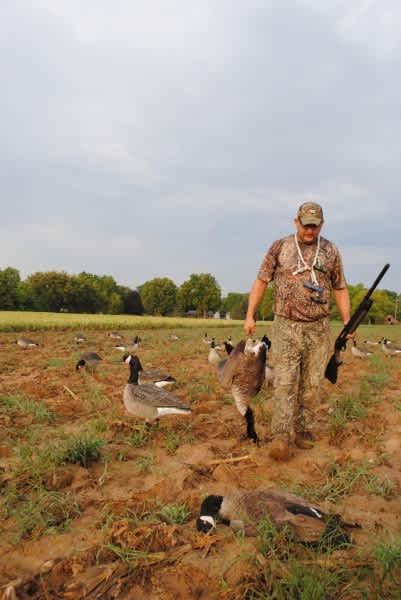The Evolution of Goose Hunting in Michigan
Bob Gwizdz 09.11.12

Just after we’d set up a little more than five dozen full-bodied Canada goose decoys and settled into our lay-out blinds in a small, picked sweet corn field here, the mallards started dropping in.
It’s the kind of experience I’ve had numerous times during the early goose season over the years; one that never seems to happen for me during duck season. But it’s also typically been a good sign: when the ducks are working the field, the geese are generally right behind them.
And so it was this day, too. A flock of maybe 20 Canadas came from out of the sun and approached our set. They circled three or four times – once directly overhead, no more than 60 feet in the air – prompting Shea Hegedus to ask Joe Robison whether we should take them. (Robison replied, “no, let ‘em work.”) But when they finally did commit, they circled well wide of the set and landed on the edge of shooting range with the landowner’s home directly in the line of fire.
Rats.
“I’m getting them up,” Hegedus said.
Wise move. You cannot compete with live decoys.
Hegedus rolled out of the blind and swung wide of the field with the idea that he’d spook them so they’d fly directly in front of us and offer some shooting. But the geese headed directly away from Hegedus (and us). Hegedus managed to squeeze off a couple of rounds and dropped a pair of the giant geese.
So we were in the plus column. But the way the birds worked was disconcerting.
“The first group in the morning often tells you how it’s going to go,” said Joe Robison, a 42-year-old Michigan Department of Natural Resources wildlife biologist.

He was right. The birds – which arrived in groups ranging from about four to a dozen during the first hour of the morning – worked the field, but refused to finish. We shot them at less than ideal distances when they either flared at the last second or were getting ready to drop in outside the decoys. And several small flights circled several times before they smelled a rat and decided to go elsewhere, too.
We wound up killing 10 birds (half of the legal limit) in the 90 minutes we spent hunting.
“They were picking us out,” said Robison, who runs Pointe Mouillee State Game Area and is responsible for the operation and maintenance of all the DNR’s managed waterfowl areas in southeast Michigan. “The blinds were either casting shadows or showing a different color than the ground or something.”
We’d done a fair job of camouflaging them, running corn stalks and clumps of grass (that had sprung up in the field since the harvest) through the loops on the outside of the blinds. But it didn’t matter; the geese could tell something was up.
“Ten years ago, we’d have gotten them,” Robison, said. “Ground blinds are just not effective as they were maybe even five years ago.”
As goose hunting has evolved in Michigan, so have the geese. Although the geese are far more numerous than they were two decades ago – Canada goose numbers are above the Wildlife Division’s management goal – they are not nearly the suckers they once were.
Those who remember the earlier days of Michigan goose hunting (which, outside of a few select areas where the migrants came through, is really not all that long ago) can recall small spreads of simple shell decoys (or even just silhouettes) totally flummoxing the birds. These days flocked, full-body decoys pivoting on stakes so they move with the winds are not often enough.
“If you can’t hide properly, even the best decoys in the world won’t do any good,” Robison said. Indeed, concealment is the second most important variable in the good-hunting equation (being where the geese want to be is, of course, number one).
“When I got my first ground blind, back in 1995, it worked awesome,” Robison said. “Now, everybody’s got them. The geese are so heavily pressured these days – especially in southeastern Michigan – that they don’t miss a thing.”

Robinson prefers to hunt from a fence row or a ditch or from standing corn rather than from field blinds whenever he can. Pit blinds are perfect, too, though it isn’t very practical (or cost effective) to try to get a back hoe into a small ag field for a few days of hunting. Robison said we would have been better off setting up in the standing corn on the north end of the field (we were adjoining a patch of beans on the south), regardless of the wind direction.
The other alternative would have been to lay flat on the ground in between the rows of beans, though getting into a landowner’s standing crops is poor form.
Although we didn’t smack ‘em the way we’d hoped, Robinson said he’s had excellent results the first week of the early season this year. He had two 20-bird (four-man limit) days out of the first four days of the season and offered “if we’d have set up in the corn, we’d have gotten our 20 birds” this day, too.
Hindsight, eh?
Still, to think that four guys could go out in a non-descript ag field and kill 10 geese and consider it slow? When I was a kid, I’d have said you were dreaming.
For more information on Michigan hunting go to michigan.org.

